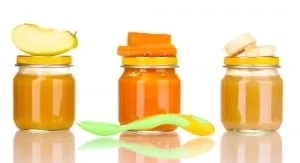How a Nutritionist Buys Baby Food - Part 2
Now that you’ve learned all my principles for buying baby food (from Part 1 of this article), what does it look like at the store if you take all these factors into account? Well … surprise surprise … it means you have to read the nutrition label and list of ingredients at the store. You knew I was going to say that, didn’t ya? You’re really getting to know me!
There’s a few things we need to remember about food labels and the food industry in order to understand the label.
The list of ingredients are given in order of volume – the first ingredient is the majority.
Baby food companies want you to buy more baby food.
Meat is expensive and fruit is sweet.
I tried to convince you earlier to feed meat to your baby. It can be hard to find baby food with meat in it, but there are more and more such “meals” appearing on the market. Just know what you’re buying! Often something like a “Turkey Thanksgiving” baby food meal in a jar will have turkey, but it is almost the last ingredient listed, meaning there is not that much meat in the jar. The opposite is true for fruit. Often, you’ll see fruit and veggie blends advertised as “Broccoli, Spinach and Pear” but the ingredients likely ready: “Pear, broccoli, spinach”. Translation: this contains mostly pear with a little bit of broccoli and spinach. I don’t have anything against pears, but I DO want parents to know what they are feeding their babies! And I prefer to see more nutrient-dense veggies than sweet fruits.
And remember, the sweeter the food, the more likely your baby is to accept it on the first offering, which means the more likely you are to purchase it again. That’s what the food industry is hoping for.
I filmed a video of myself shopping for baby food at the store.
To see how I put these principles into action. Watch it here!
So what‘s the best solution? Well, it’s likely organic homemade baby food. But let’s get real … not even I make all my own baby food. We’ve all got too much going on. What you can easily do is purchase with the intention of mixing. I do like the mixed meals with meat in them especially when they are organic. And those pouches are so awesome for traveling! I also highly recommend mixing your own. Combine a veggie-only mix with one of the small jars of baby food meat (Gerber and Beechnut sell these).
I also recommend mixing if you want to feed your baby the sweet dessert-type fruit. Add healthy fats to these. Try stirring in a mashed up avocado with that pureed pear.
Coconut cream is a great healthy fat too. You can buy coconut cream in the can (look for organic if possible), or just buy full fat coconut milk and scrape off a tablespoon of the hard white top layer (the fat) to stir in with some of the fruit. This “cream” will soften up right away when you heat the food. Adding a teaspoon of coconut oil to a jar of fruit will add to your homemade baby food some nice healthy fat and help slow the sugar rush.
Peanut butter is another great fat and protein source if your baby has already had it and doesn’t have a history of food allergies. Try mixing it with some squash for a peanut-curry style flavor for baby.
I filmed a video of myself mixing up baby food at home to help you see
how I put these principles into action. Watch it here!
Remember, you’re the expert on your own baby. This is all information to help you make educated choices. My goal is to have you stand in the baby food aisle in front of hundreds of options and feel empowered, not overwhelmed. You aren’t swayed by marketing because you are confident about what your baby needs and how you are going to give it to her. You rock!
xo Dr Young



